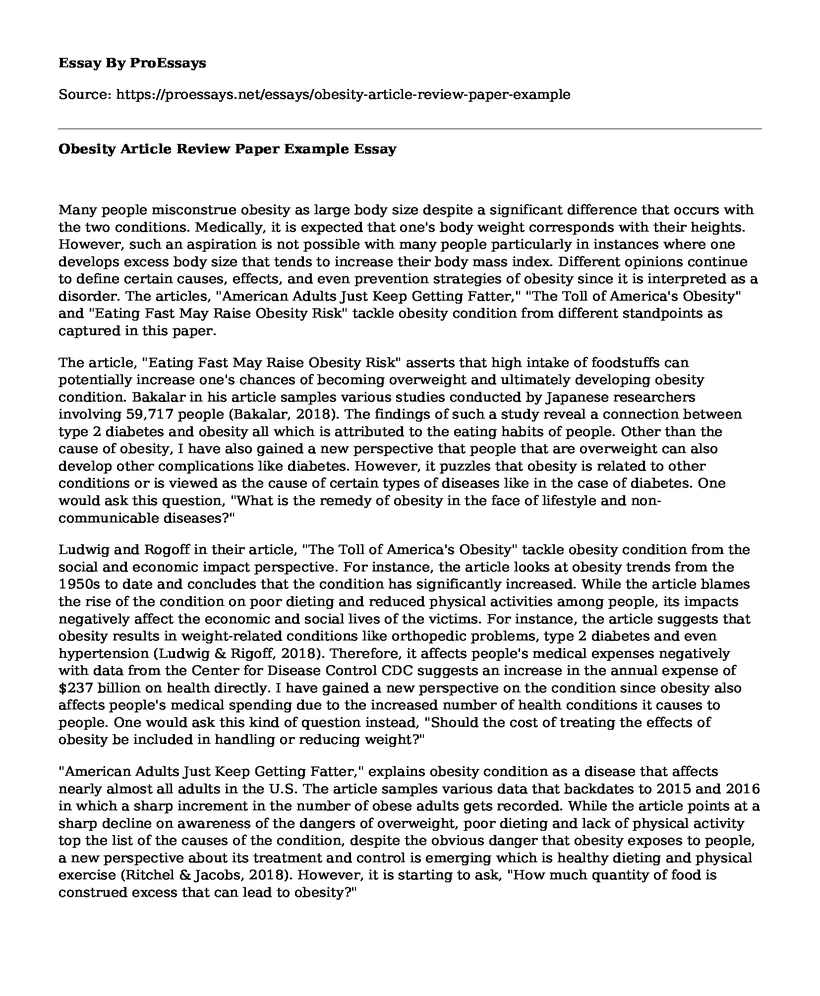Many people misconstrue obesity as large body size despite a significant difference that occurs with the two conditions. Medically, it is expected that one's body weight corresponds with their heights. However, such an aspiration is not possible with many people particularly in instances where one develops excess body size that tends to increase their body mass index. Different opinions continue to define certain causes, effects, and even prevention strategies of obesity since it is interpreted as a disorder. The articles, "American Adults Just Keep Getting Fatter," "The Toll of America's Obesity" and "Eating Fast May Raise Obesity Risk" tackle obesity condition from different standpoints as captured in this paper.
The article, "Eating Fast May Raise Obesity Risk" asserts that high intake of foodstuffs can potentially increase one's chances of becoming overweight and ultimately developing obesity condition. Bakalar in his article samples various studies conducted by Japanese researchers involving 59,717 people (Bakalar, 2018). The findings of such a study reveal a connection between type 2 diabetes and obesity all which is attributed to the eating habits of people. Other than the cause of obesity, I have also gained a new perspective that people that are overweight can also develop other complications like diabetes. However, it puzzles that obesity is related to other conditions or is viewed as the cause of certain types of diseases like in the case of diabetes. One would ask this question, "What is the remedy of obesity in the face of lifestyle and non-communicable diseases?"
Ludwig and Rogoff in their article, "The Toll of America's Obesity" tackle obesity condition from the social and economic impact perspective. For instance, the article looks at obesity trends from the 1950s to date and concludes that the condition has significantly increased. While the article blames the rise of the condition on poor dieting and reduced physical activities among people, its impacts negatively affect the economic and social lives of the victims. For instance, the article suggests that obesity results in weight-related conditions like orthopedic problems, type 2 diabetes and even hypertension (Ludwig & Rigoff, 2018). Therefore, it affects people's medical expenses negatively with data from the Center for Disease Control CDC suggests an increase in the annual expense of $237 billion on health directly. I have gained a new perspective on the condition since obesity also affects people's medical spending due to the increased number of health conditions it causes to people. One would ask this kind of question instead, "Should the cost of treating the effects of obesity be included in handling or reducing weight?"
"American Adults Just Keep Getting Fatter," explains obesity condition as a disease that affects nearly almost all adults in the U.S. The article samples various data that backdates to 2015 and 2016 in which a sharp increment in the number of obese adults gets recorded. While the article points at a sharp decline on awareness of the dangers of overweight, poor dieting and lack of physical activity top the list of the causes of the condition, despite the obvious danger that obesity exposes to people, a new perspective about its treatment and control is emerging which is healthy dieting and physical exercise (Ritchel & Jacobs, 2018). However, it is starting to ask, "How much quantity of food is construed excess that can lead to obesity?"
Conclusion
In conclusion, researchers continue to give new perspectives about obesity in varied dimensions. The articles above tackle the condition from its cause, effects, and prevention standpoints. For instance, "Eating Fast May Raise Obesity Risk" article blames too much intake of foodstuffs as the root cause of the condition. However, it is puzzling that the viable remedy of obesity remains challenging in the face of rampant infections associated by it. "The Toll of America's Obesity" article reveals the challenges of social and economic impact that comes with obesity in which one wonders whether the actual cost in treating the condition should be included in handling its symptoms. Finally, "American Adults Just Keep Getting Fatter" article reveals a new dimension in the people affected mostly with obesity as American adults top the victim list.
References
Ludwig, D., S., & Rigoff. K., S., (2018). The Toll of America's Obesity. The New York Times. Retrieved from https://www.nytimes.com/2018/08/09/opinion/cost-diabetes-obesity-budget.html on Thursday, December 13, 2018
Nicholas Bakalar. (2018). Eating Fast May Raise Obesity Risk. The New York Times. Retrieved fromhttps://www.nytimes.com/2018/02/22/well/eat/eating-fast-may-raise-obesity-risk.html on Thursday, 13th December 2018 at 10:00 Am.
Ritchel, M., & Jacobs. A., (2018). American Adults Keep Getting Fatter. The New York Times. Retrieved from https://www.nytimes.com/2018/08/09/opinion/cost-diabetes-obesity-budget.html on Thursday, 13th December 2018
Cite this page
Obesity Article Review Paper Example. (2022, Oct 19). Retrieved from https://proessays.net/essays/obesity-article-review-paper-example
If you are the original author of this essay and no longer wish to have it published on the ProEssays website, please click below to request its removal:
- Reflections on Nursing Practice Essay
- Essay Example on HL7: A Standard for Healthcare Information Management
- Essay Example on Abortion Debate: Escalating Arguments & Controversies
- Paper Example on Nurse Practitioners: Improving Public Health & Well-Being
- Paper Example on Analysis of Helmet Lattice Liner Performance on Mitigating TBI
- Essay on Strategic Policy Framework for Enhancing Cancer Care: Maximizing Quality, Minimizing Cost
- Paper Example on Analysis of Prehospital Rapid Sequence Intubation in Emergency Service South Africa







